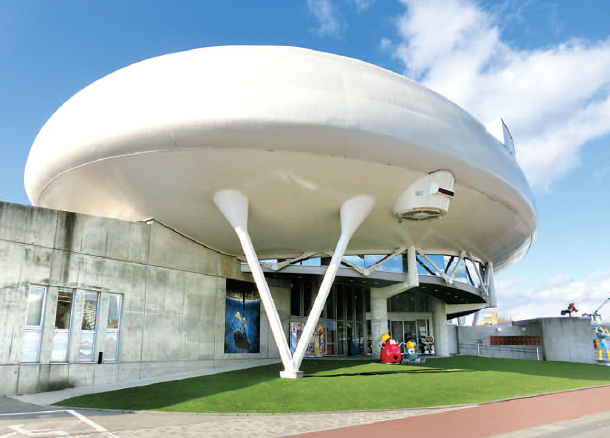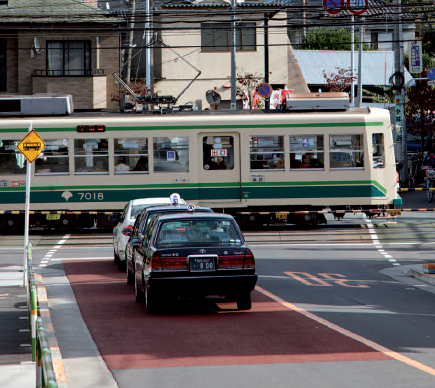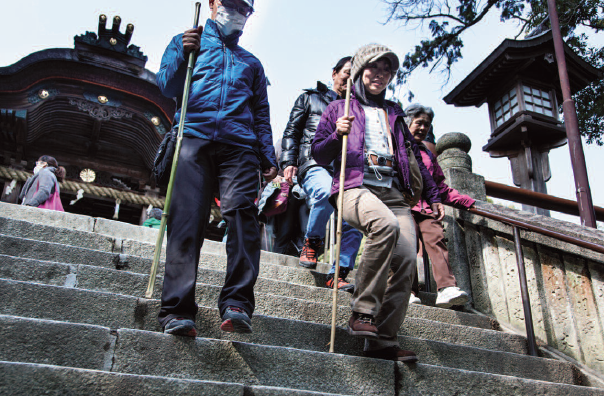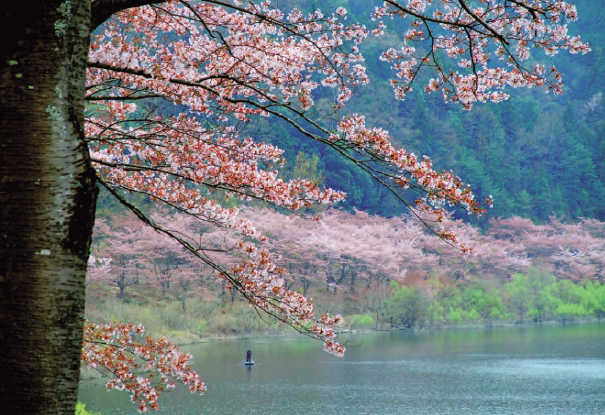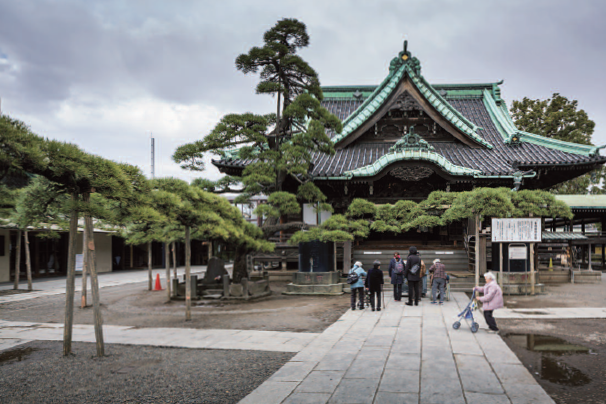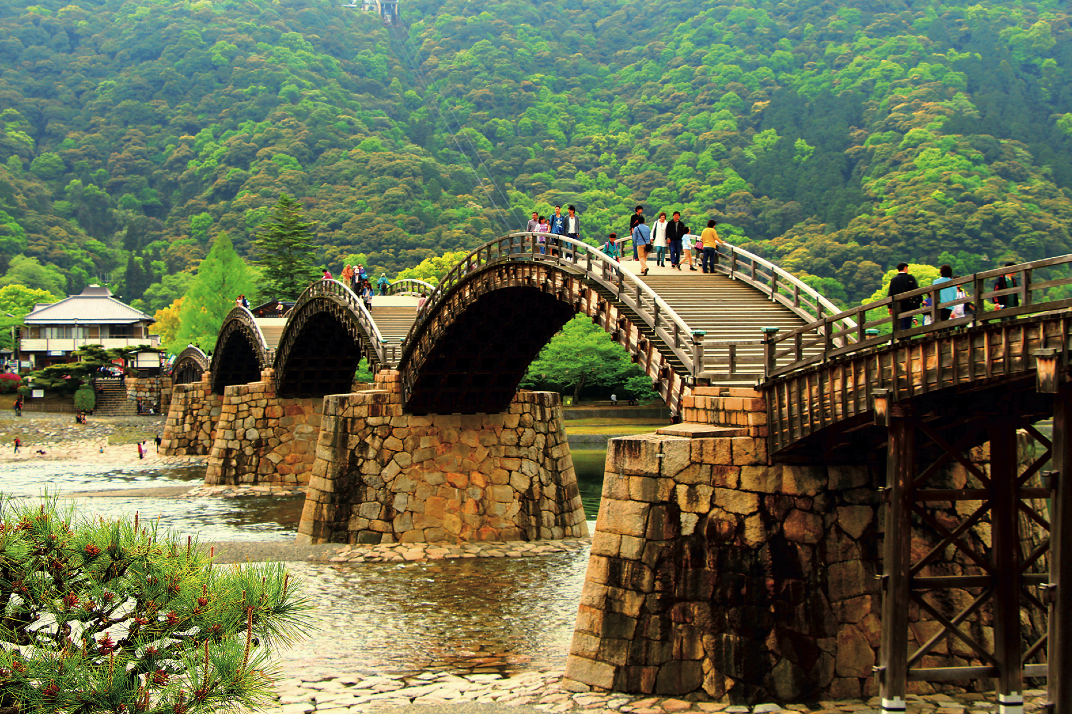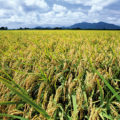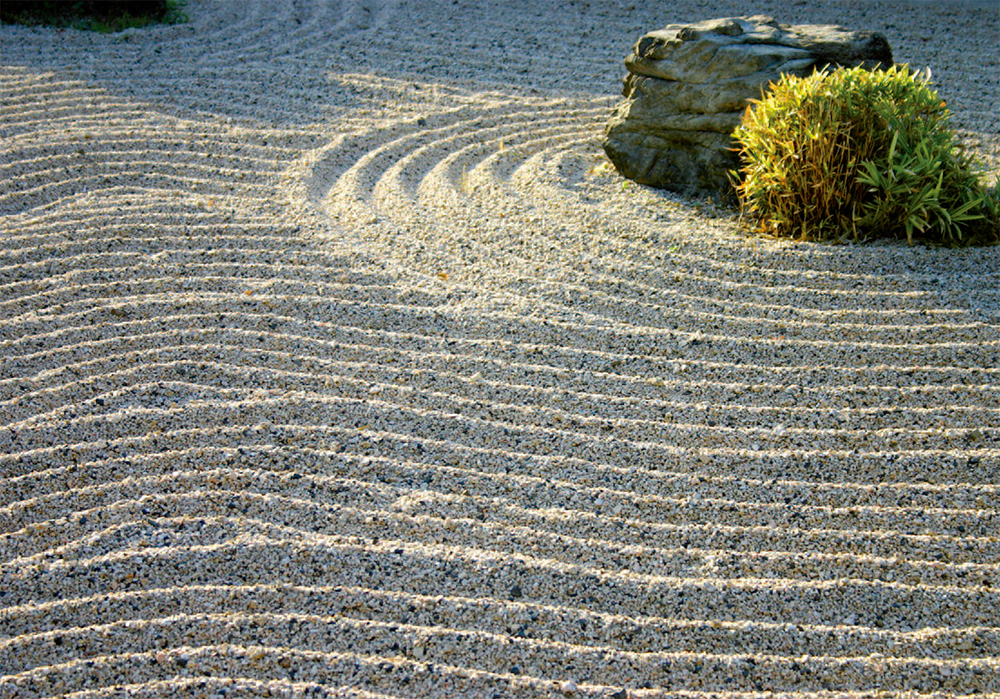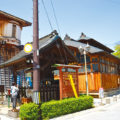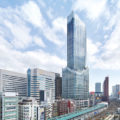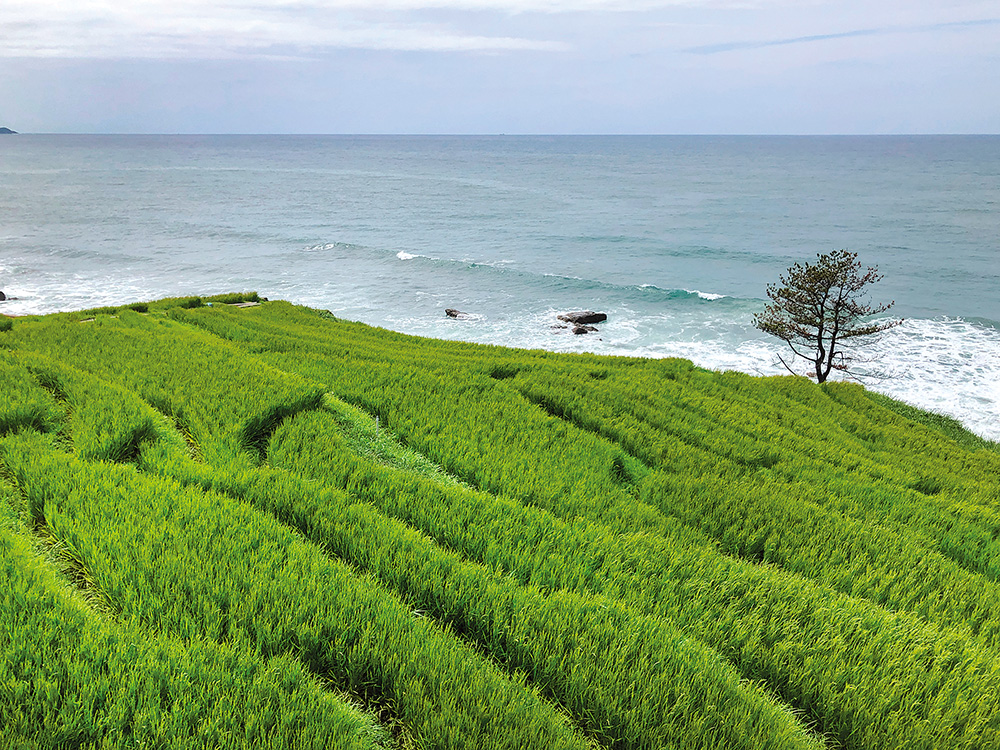

Located in the north of the peninsula, the Shiroyome Senmaida rice fields plunging down to the Sea of Japan are one of the must-see attractions.
Often overlooked by tourists, the peninsular overflows with treasures such as terraced rice fields.
If you scan the map of Japan, your eye will be caught by the mysterious and strangely shaped peninsula that projects from the
western coast; a striking shape with many deep bays and bold headlands. That’s Noto. Though close to Kanazawa, one of Japan’s most popular tourist destinations, most people tend to bypass Noto, which is a pity because there are plenty of things to enjoy there. The interior of the peninsula is lined with hills (the Hodatsu Hills in the south and the Noto Hills in the north) at an altitude of 200 to 500 metres, and there is little flat land. Although the terrain and climate are harsh, from the Edo to the Meiji period the peninsula was also a relay point for trade in the Sea of Japan: the so called Kitamaebune trading route along which ship owners plied their trade between Osaka and Hokkaido, buying and selling a great variety of goods. In this way, a unique culture and spirit were nurtured in Noto. As the saying goes, “Noto is gentle, as is its soil”, meaning that not only are its people kind but the local soil is also good.
Speaking of soil, one of Noto’s most popular spots is the Shiroyone Senmaida, a terraced rice field not far from Wajima City. It is part of Japan’s first World Agricultural Heritage site, the Noto no Satoyama Satoumi. It was also selected as one of the 100 Best Rice Terraces in Japan and designated as a National Special Place of Scenic Beauty.
Small rice fields are carved out of the hillsides descending towards the Sea of Japan so that they overlap. The site is worth a visit at any season: in spring when water is drawn in preparation for rice planting, in summer when the seedlings are sprouting, and in autumn when the rice ears are growing. Also, in winter, an illuminated event is held with 20,000 solar LEDs placed all around the fields. It’s exceptionally beautiful at sunset.
Wajima is also the centre of a thriving fishing industry. Since ancient times, sea cucumbers have been a local delicacy, and now, oysters are alsocultivated. Toenjoylocalfoodculture ,you should not miss the Wajima Morning Market, one of the three major morning markets in Japan (along with Yobuko and Katsuura), which claims to date back more than 1,000 years. With more than 200 stalls lining its main commercial street, it’s divided into categories such as fresh seafood, flowers and agricultural products, folk crafts, processed foods, clothing, and miscellaneous goods. Almost everything else you need for daily life is available here. Often, there is no price tag, so you can enjoy interacting with the locals for a healthy bout of bargaining.
Noto is famous for its Kiriko Festivals that are held in many places around the peninsula between August and October, each one with slightly different characteristics. The festival takes its name from the huge kiriko (lantern floats) that are paraded during the festivities. Some of them are so big that they are carried by nearly 100 people. The oldest kiriko (preserved in the Wajima Kiriko Art Museum dates from 1853 and is made entirely of Wajima lacquerware.
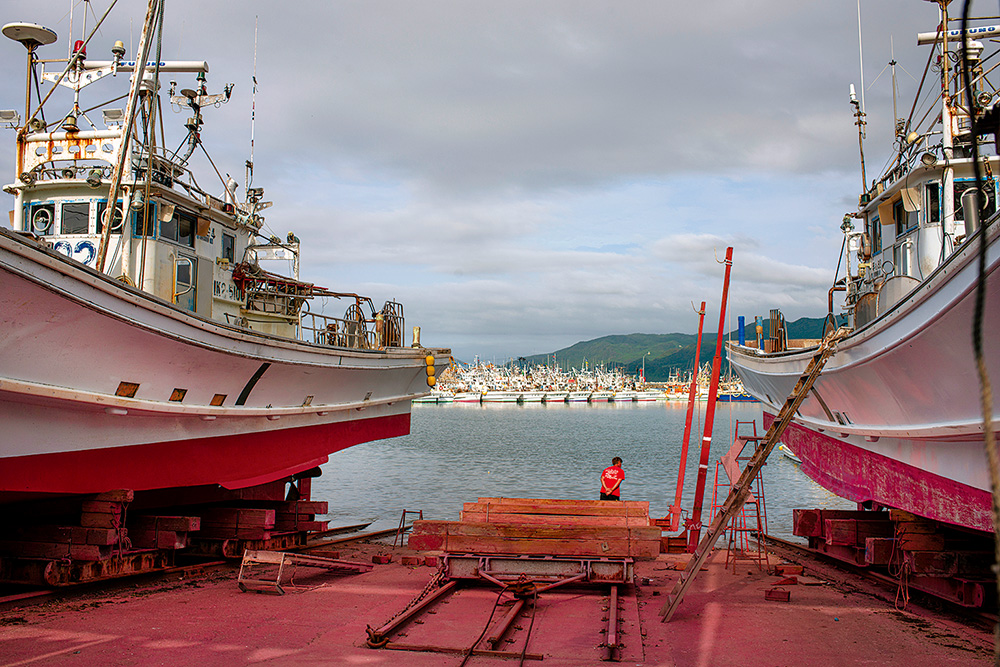
Wajima, once a trading port, is also famous for its fish and its morning market.
Noto Island, located in Nanao Bay, is home to Iyahime Shrine’s Koda Fire Festival, one of the three biggest fire festivals in Japan. According to legend, Iyahiko (male deity), who formed the Province of Echigo (now Niigata Prefecture), visits the island to see his lover Iyahime (female deity) once a year on this day.
A portable shrine arrives in the square after a ceremony at the shrine. 7 kiriko lanterns of different sizes are paraded to the music of gongs, drums and flutes. A 30 metres-tall, huge cone-shaped pillar torch welcomes the parade in the square. It’s claimed to be the largest such pillar torch in Noto.
The rhythm of the music then becomes more uptempo. People run around the pillar torch holding small torches made of straw. The highlight of the festival is when they throw the torches at the pillar. The fire reaches the top in an instant and huge flames light up the night sky. They say that if the pillar falls towards the mountains, the harvest will be good, and if it falls towards the sea, the fish catch will be good. The pillar torch is supposed to bring long life. When it finally falls to the ground, people dash over to it to get a piece of it, and the festival reaches its climax.
Saikai Festival in Shika Town is conducted jointly by two fishery centres to pray for a good catch and the safety of fishermen. Women participate in the festival instead of men in these areas, as men have traditionally been out fishing or on other work-related trips. That’s why women carry the kiriko in this festival.
When the Togi-miyuki drum is beaten as the sun sets into the Sea of Japan, the festival begins. A mikoshi (portable shrine) and kiriko are carried around town while revellers sing the festival song. When the procession arrives at the intersection of five roads, the kiriko are carried up the hill one by one, their tops oscillating wildly.
The female kiriko carriers are just as brave as their male counterparts. They fascinate the audience as they perform energetically dressed in a yukata (cotton summer kimono), a kimono underskirt and a white apron.
This, however, is not the end of the fun: when they return to their respective shrines, the mikoshi and kiriko start to fight. The kiriko car riers and local residents try to stop the mikoshi from entering the shrine to prevent the festival from ending. The mikoshi and kiriko dance wildly, and the excitement builds.
Unlike most Noto kiriko festivals, which reach their climax at night, the Okinami Tairyo Festival, which is held in the Okinami area of Anamizu Town, takes place during the day. According to legend, the deity of Okinami Suwa Shrine drifted ashore, which is why kiriko lanterns are carried to the sea for a purification ceremony, and to pray for a good catch and the safety of the fishermen.
On the first day of the festival, when fireworks are set off in the night sky, kiriko visit Okinami Suwa Shrine to join the portable shrine, and then they are paraded around the town. After that, the portable shrine is carried to Ebisu Shrine in Ebisuzaki. The kiriko dance in the precincts of the shrine accompanied by the sound of drums and gongs, and loud, rhythmic shouting.
On the morning of the second day, when the kiriko lanterns gather at the beach, Okinami Tairyo drums are beaten rhythmically, and the carriers enter the sea one by one as a whistle is blown. They dance vigorously in the water up to chest height. As the drums are beaten more loudly, the kiriko absorb water and become heavier. However, the dance continues amid all the splashing. When the whistle sounds, the kiriko return to the beach.
The first kiriko festival of the year is also the most dynamic and “dangerous”. It’s not by chance that it’s called Abare (rampage) Festival. The main feature on the first day of the festival is the kiriko. In the evening, more than 40 kiriko floats line up. At nine o’clock, fireworks are set off as a signal to start the festival. The kiriko floats are carried to Iyasaka Square, in front of the town hall. When they arrive, five 7 metre-tall pillar torches are lit. The kiriko floats keep moving around the pillar torches to the sound of drums. The excitement of the participants and the audience increases at the sight of flames and falling sparks, and the festival reaches its climax.
The real rampage, though, is yet to come: on the second day, the portable shrines set off for Yasaka Shrine, with kiriko in front and behind. To loud cheering, the carriers throw the portable shrines into the sea and river, and into a bonfire. The highlight is when they throw the portable shrines into the river from Kajikawa Bridge, roll them in the water and climb onto them. After they arrive at the shrine, they throw the portable shrines onto the flames of the burning torches, and beat them, creating sparks. The portable shrines are thrown into the fire. The festival ends after two o’clock in the morning, when the portable shrines, which have somehow miraculously survived the beating, enter the worship hall of the shrine.
Even if you don’t have a chance to visit Noto during festival time, you can still admire many examples of kiriko at the museum in Wajima. The lanterns are exhibited to recreate a festival atmosphere. The 5 metres-tall kiriko exhibited in the museum is still used at the Wajima Grand Festival held in August every year.
Even today, not many foreign tourists venture to Noto but 130 years ago, American author and astronomer Percival Lowell (the same guy who fuelled speculation that there were canals on Mars) was struck by the oddly shaped peninsula (“Its coastline was so coquettishly irregular”.) and out of curiosity, he decided to pay it a visit. He even wrote a book about his picaresque adventure, Noto: An Unexplored Corner of Japan (1891).
When Lowell arrived in Noto, in May 1890, he was the third Westerner to set foot on the peninsula: “two Europeans had (…) descended upon the place the summer before. (…) Lured by the fame of the [hot] springs, these men had come from Kanazawa in Kaga, where they were engaged in teaching chemistry, to make a test of the waters at Wakura Onsen”.
Though moving around Noto is much easier now, the atmosphere depicted by Lowell during his trip is still much the same: “The road threads its tortuous course for miles through the rice plain, bordered on either hand by the paddy fields. Groups of steeply roofed farmhouses were surrounded by a sea of rice”. Lowell became an instant celebrity among the locals who had never seen a Westerner. One night, for instance, the local prefect came to check Lowell’s passport and declared with some pride that he had himself once been to Tokyo.
The highlight of Lowell’s trip is when he catches a small boat plying the quiet waters of the local inland sea. “Land, at varying picturesque distances, lay on all sides of us. (…) The eye wandered down a vista of water framed by low headlands for ten miles or more. The overall atmosphere was akin to a strange slumber-like seclusion. (…) it shut this little corner of the world in a sort of happy valley of its own”. Here Lowell discovered a most singular aquatic structure: four poles planted in the water inclined towards one another at such an angle that they crossed three-quarters of the way up. The projecting quarters held a large wicker basket, and peering above the basket was a man’s head. “It looked like the skeleton of some antediluvian wigwam which a prehistoric roc [a mythical giant bird] had subsequently chosen for a nest”.
It turned out that the man perched on top of the basket was fishing. The wigwam was connected by strings to the entrance of a sort of weir, and the man who crouched in the basket was on the lookout for large fish. As soon as one of them strayed into the mouth of the net, the man pulled the strings which closed the opening.
Eventually, Lowell got permission to climb into one of the lookouts. “The higher I clambered, the flimsier the structure got. (…) The way the thing swayed and wriggled gave me to believe that the next moment we should all be shot catapult-wise into the sea”.
In those times, the whole coast was dotted with those lookouts. They stood a few metres out in deepish water. Today, only two have been preserved near the city of Anamizu. They certainly make for an arresting view.
Anamizu is another lovely place to visit as the coast and Noto Island create the impression of an inland sea: fold upon fold of low hills in the distance, with hamlets visible here and there at their bases by the sea.
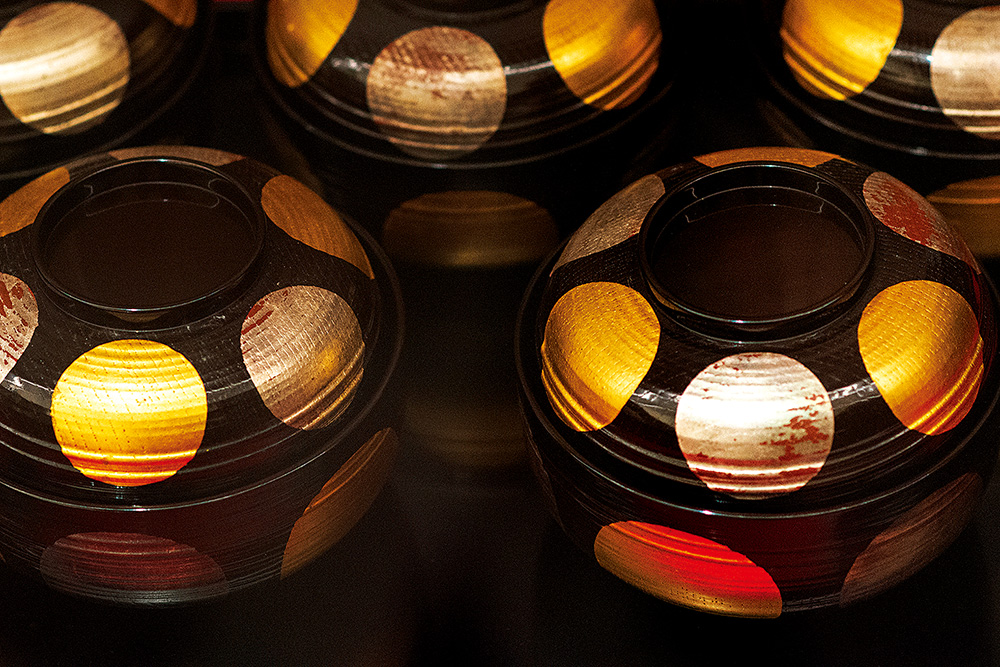
Wajima lacquerware is particularly resistant.
According to Lowell’s travelogue, he only spent about an hour in Anamizu before taking another small boat back to Nanao. But the locals were so impressed with his visit that they built a small monument in his memory and apparently even have their own Lowell Festival.One cannot talk about Noto without mentioning Wajima’s famous lacquerware, Wajima-nuri. Wajima is the biggest producer of wood-based urushi ware in Japan and, in 1977, it was the first urushi producing area in the country to be designated an Important Intangible Cultural Asset by the Japanese government. The main distinguishing feature of Wajima-nuri is its durable undercoat that is achieved by the application of multiple layers of urushi mixed with powdered earth onto delicate zelkova wood.
So why did Wajima-nuri develop here? Wajima has long prospered as a base for maritime transport. It’s believed that exchanges with China and the Korean Peninsula have taken place since ancient times. Lacquer art technologyfirstoriginatedinChina,andWajima is said to be the place where it was first introduced to Japan.
Wajima, located at the northern end of the Noto Peninsula, was a port of call for Kitamaebune and other vessels, and by this time it had already expanded its sales channels by taking advantage of shipping.
In Wajima, there is a rich forest that grows trees which are indispensable for making lacquerware, such as sumac, cypress, and ate (asunaro tree). It also has a suitable climate. However, the main reason for its development here has to be the commitment and passion of those first artists who endeavoured to make excellent products, and created a special production system, sales network, and quality control standards.
Gianni Simone

